It is usually difficult to decide what to write about each month, and this
month is no exception. It is not because there are too few things to report, but
rather too many items to choose from. This year I went to the Denver show, the
National in Marlborough, the Western Regional show in Visalia and the Central
Regional show in London. Oddly enough I was not able to make the two local shows
sponsored by the Lone Star Insulator Club - the March show in Dallas and the
September show in Houston. Family matters forced me to drop out of the March
show and the Visalia show conflicted with the September show. The shows I did
attend were great. You should have been there (if you weren't)! Shows are well
worth the drive if for nothing else but to renew friendships and see those whom
you have corresponded with.
The greatest event of the year for me was seeing
Bill Rohde's collection on Monday after the Visalia show at his parent's ranch
outside of Fresno. Mr. Rohde had spent about four weeks dusting each of the
nearly 10,000 insulators, and he did not drop a single one on the concrete
floor!! Several major porcelain collectors were there: Robin Harrison, Jeff
Hogan, and Jeff Kaminski. Unfortunately Mike Guthrie could not attend because he
and Becky were recuperating from a recent spill on their motorcycle. Walter
Ruedrich (of San Francisco wooden insulator fame), Bill and Arlene Heitkotter,
Butch and Eloise Haltman, and Ofelia and Dwayne Anthony also attended.
The glass
collectors showed an obvious interest in porcelain. It was easy to be in awe of
Bill's super porcelain collection. His two dozen(!!) gray multiparts (circa 1904-1910) were beyond belief easily
winning first prize for the number and variety of gray styles. Many thanks to
Bill and Mr. and Mrs. Rohde for putting together a feast of the eyes and stomach
that will be remembered well into the next century. It was truly a porcelain
collector's dream come true!!
The prices of good glass insulators are
skyrocketing as the slick marketing techniques of privately published insulator
sales catalogs encourage people to bid higher than market prices to capture a
nice crown jewel. The really good color and rare glass is seldom available at a
show because the realized prices from the catalogs seem to attract all the rare
stuff. A lot of collectors are getting turned off by the rapidly escalating
prices which leave most of them hard pressed to add something new and exciting
to their collection at a reasonable price. Jokingly one might ask, "Should
I bid on those three insulators or use the money to buy a new work car?' Many
collectors are turning their interest to the much cheaper porcelain insulator.
Where else can you get a rare insulator (ex. less than 10 known) for pennies on
the rare-glass dollar? Typically the price for rare porcelain is one-tenth the
cost of a comparably rare glass insulator, and values can still be found at a
show that bring the cost down even more. Also the color variety, even in the
'brown' category, can be quite interesting and inexpensive.
The
availability of the reprint of Tod' s Porcelain Insulator Guide Book and my new
Value Guide will hopefully aid a renewed interest in porcelain insulators. The
growing interest in collecting porcelain insulators was very evident at shows
this year. I was amazed to see that nearly every dealer at the London, Ohio
Central Regional show (almost 80 tables) had at least a few porcelain
insulators, and many dealers had a very large selection to choose from. That
show was fantastic, and it is definitely in my plans for next year.
Bill Rohde
(NIA # 1219) had many rare, unusual, and seldom seen porcelain insulators in his
collection which are far too numerous to mention in a dozen PIN columns.
However, I have picked out a few interesting items to share with you. The first
photograph shows several varieties of U-241A with the "JOHNS-MANVILLE"
marking. All four insulators were made by Pittsburg High Voltage Insulator Co.
No whole specimens in either
white or blue glaze have been found with that marking, and I don't think an
unmarked blue one has been found either. Bill's damaged white insulator and the
top to the light blue one were found at the Pittsburg dump.

U-241A with Johns-Manville marking
(left to right: mottled brown, N-N white,
white, light blue)
The next photograph shows two more Pittsburg dump items. The insulator on the
left is U-393 and the one on the right is U-393A. No whole specimens of either
have been found with a brown glaze. Only white glazed specimens of these styles
have been reported.
The next photograph shows the rare U-408 on the left cataloged by New
Lexington and the rare U-408A in the center which was probably made by either
Lima or Locke (right after Fred Locke left the company in 1904). Nothing new
here. The unusual insulator is the U-408 on the right. This insulator was
obviously made by Pittsburg! Pittsburg was noted for copying insulator styles of
other companies. Either the Pittsburg version was a direct copy of the New
Lexington style or an order was made for additional or replacement insulators
that a company already had in service. The Pittsburg U-408 is the only one
known.
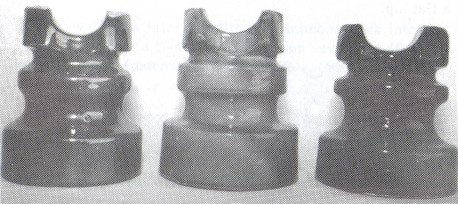
U-408, U-408A, U-408 (Pittsburg)
Tom Moulton (NIA # 169) reported a very interesting U-709A with a metallic
tan glaze. On the top firing rest is the incuse marking: "8 08 7 SUN".
The 1/8-inch tall numbers and letters are much larger than the date stamps used
by Imperial.
The metallic tan glaze is similar to 1901-1994 dated Imperial insulators;
however, the bottom edges of the petticoats are flat. We have been trying to
determine which company made several different styles of insulators with these
characteristics. Our best guess at this time is that they were made by either
Thomas or New Lexington. A similarly marked U-746 (marked 2 11 07) and U-709A (2
05 07) were reported in 6-85-18 issue of Crown Jewels of the Wire. In that
article I speculated that New Lexington used that marking. Note that
"07" was used and the markings with the day of the week
"SUN" used only "7". I have seen all the markings and they
are identical in characteristics. Often there are fine grains of sand embedded
in the numbers as if sand was used on the firing tray in case traces of glaze
were left after the firing rest was filed off. One argument that these were made
by Thomas is that several specimens of U-144 have been found with this same
glaze and flat-edged petticoat. The top of the fully glazed pinhole is flat
which is characteristic of early Thomas insulators. However, the dated
insulators have unglazed pinholes and the top of the pinhole on most of them is
poorly formed, punched in, or cut. I picked up a U-709A at the London show this
year with the date "8 27 7 SUN". It is identical to Tom's insulator
and the unglazed pinhole does have a flat top.
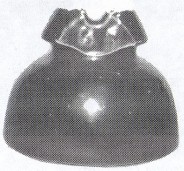 |
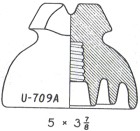 |
|
U-709A with incuse date marking "8 08 7 SUN" |
The London, Ohio NIA Central Regional show this past November brought out a very interesting insulator.
Rob Lloyd (NIA #3414)
found the insulator and made sure it found its way into Ken Willick's (NIA
#3709) collection. The insulator was the two-part glazeweld style U-922A with
the incuse marking "LIMA, N.Y." on the side of the crown! A few
unmarked U-922A's were just reported a couple of years ago. We speculated then
that they were made by Lima, and Rob's insulator quickly confirmed our
suspicions.
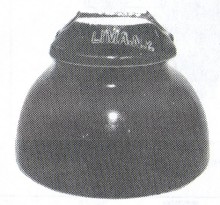 |
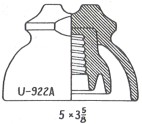 |
|
U-922A marked "LIMA, N. Y." |
It was most interesting to see someone walk into the London show with a
U-401A. I have seen several U-401 Fay Clamp insulators (patented July 28, 1908),
but I have never seen a U-401A. What made this insulator even more unique was
that it had the original porcelain "button" that fit into the top
where, it was pressed against the cable and held securely by the cast iron screw
clamp. The bail-type clamping device, which eliminated the need for a tie-wire;
has never been found. These insulators were designed by John L. Fay, general foreman of overhead line construction of the Union Electric Light & Power
Co., St. Louis, MO. The insulators were used on arc light circuits and 4400-volt
distribution lines in St. Louis where nearly 20,000 were used by 1912. The
insulator, complete with bale clamp and parts, was sold for 11 cents each. The
insulators were manufactured by the Ohio Brass Co. as shown in a 1910 scale
drawing that Jack Tod acquired from the factory.

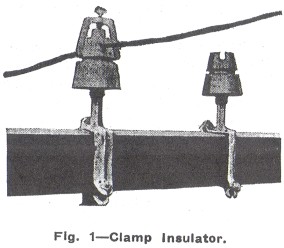
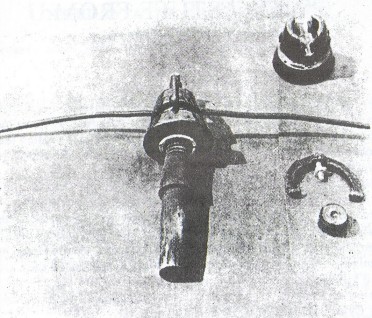
Fig. 1 -- Clamp Insulator and Parts.

Fig. 2 -- Clamp Insulators on Wooden Pins.


































































